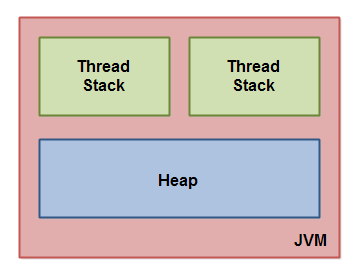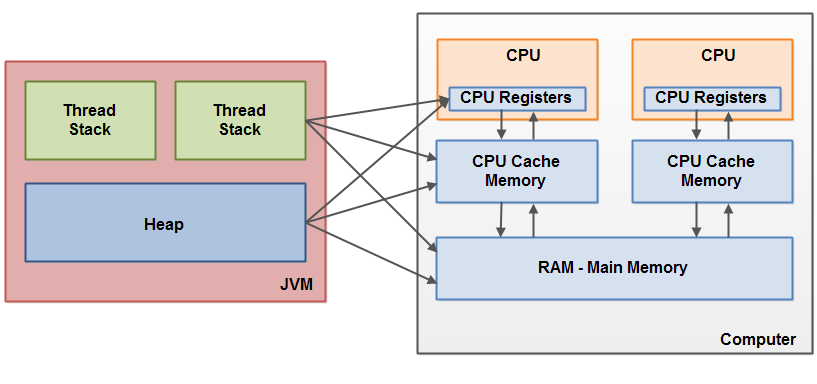Understanding the Java Memory Model and 'Happens-Before' Principle
 Ritesh Panigrahi
Ritesh Panigrahi
The Java Memory Model (JMM) explains how different threads in a Java program can see and use shared variables. It tells us when one thread make any changes to a variable that become visible to other threads and how to properly coordinate access to these shared variables to ensure everything works correctly.
JVM Memory Structure
JVM divides the memory into thread stacks and heap

Thread Stack
Each thread has its own stack containing method call information and local variables.
When a method is called, a new entry is pushed onto the stack, and when the method completes, the entry is popped off.
Local variables of primitive types are stored on the stack and are not accessible to other threads. Each thread executing the same method will have its own copy of the local variables.
If multiple threads are executing same methods, each thread will have its own copy of the local variables in their respective threads.
Heap
The heap contains all objects created in the Java application and is shared by all threads.
If any primitive variable is part of an object, that will be stored in heap section
Even if the object is created locally inside the thread, still the object resides in the heap memory, just the reference of it is stored in the thread stack as a local variable.
Let us understand above with an example
public class TaskExample implements Runnable {
public void run() {
performTask();
}
public void performTask() {
// Local variable - stored in the thread stack
int localCounter = 10;
// Reference to shared object - reference is in the thread stack, object is in the heap
SharedData localData = SharedData.sharedInstance;
// Print local variables
System.out.println(Thread.currentThread().getName() + " - localCounter: " + localCounter);
System.out.println(Thread.currentThread().getName() + " - SharedData: " + localData);
// Accessing shared object's member variables
System.out.println(Thread.currentThread().getName() + " - sharedValue1: " + localData.sharedValue1);
}
public static void main(String[] args) {
TaskExample task = new TaskExample();
Thread thread1 = new Thread(task, "Thread-1");
Thread thread2 = new Thread(task, "Thread-2");
thread1.start();
thread2.start();
try {
thread1.join();
thread2.join();
} catch (InterruptedException e) {
e.printStackTrace();
}
}
}
class SharedData {
// Static variable pointing to instance of SharedData - stored in the heap
public static final SharedData sharedInstance = new SharedData();
// Member variables pointing to objects on the heap
public String sharedValue1 = "Shared Value";
// Constructor
private SharedData() {}
}
Heap:
The
SharedDataobject, referenced bySharedData.sharedInstance, is stored in the heap.The member variable
sharedValue1ofSharedDatais stored in the heap.
Thread Stack:
Each thread (
Thread-1andThread-2) has its own stack.The local variable
localCounterinperformTaskis stored in the stack of each thread.The reference to
SharedData.sharedInstance(stored inlocalDatainperformTask) is in the stack of each thread, but the actual object is in the heap.
Hardware Memory Architecture
The Java Memory Model (JMM) is a logical concept that provides a framework for understanding how Java threads interact through memory. However, it maps into the physical hardware architecture which involves registers, cache, and RAM. Let's break this down:
At the hardware level, the actual memory interactions occur through:
Registers: These are in-CPU memory, which is small and fast storage locations used for calculations and data manipulation.
Cache: Small, fast memory located close to the CPU, used to temporarily hold data that is likely to be used again soon. It helps reduce the time to access data from the main memory.
RAM (Main Memory): The larger, slower memory where data and programs reside when they are being used.
The Java Memory Model (JMM) and hardware memory architecture are different concepts. In hardware, both thread stacks and the heap are stored in main memory, with no distinction between them. Some parts of the stacks and heap can also be present in CPU caches and registers.
So, if thread stacks and heap are at different memory locations at hardware level, this can create issues while accessing variables in case of multi-threaded environment
Visibility Issues:
Changes made by one thread to shared variables may not be immediately visible to other threads if the updates are only in CPU caches or registers. This can lead to stale data being read.
Solve - We can use Java volatile keyword for a variable, this will indicate any variable will be read from main memory and written back into the main memory once updated
Race Conditions:
A race condition occurs in a concurrent program when two or more threads access shared data at the same time and at least one thread modifies the data.
Solve - Using
synchronizedblock which guarantees only one thread will access the critical section at a time, which makes sure shared variables are not updated concurrently at the same time.
Java Happens-Before Guarantee
Suppose we have a simple data loader class that loads some data (a list of strings) and provides a status flag indicating if the data is loaded:
public class DataLoader {
private boolean dataLoaded = false;
private List<String> data;
public void loadData() {
data = new ArrayList<>(); // load data here
dataLoaded = true;
}
public boolean isDataLoaded() {
return dataLoaded;
}
public List<String> getData() {
if (!dataLoaded) throw new IllegalStateException("Data not loaded yet");
return data;
}
}
In a multi-threaded scenario, if one thread calls loadData() and another thread calls getData(), there could be a race condition. The second thread might see dataLoaded as true (because it's updated), but still gets null or partial data (because it's not fully written to memory yet).
This is because Java's memory model allows for reordering of instructions and caching of variables, which means there's no guarantee that dataLoaded is written to memory after data is fully written. The getData() method can see the updated dataLoaded but the stale data.
To solve this problem, we need to enforce a "Happens-Before" relationship between the write to data and the write to dataLoaded. We can do this using synchronized or volatile keyword.
Using synchronized:
public class DataLoader {
private boolean dataLoaded = false;
private List<String> data;
public synchronized void loadData() {
data = new ArrayList<>(); // load data here
dataLoaded = true;
}
public synchronized boolean isDataLoaded() {
return dataLoaded;
}
public synchronized List<String> getData() {
if (!dataLoaded) throw new IllegalStateException("Data not loaded yet");
return data;
}
}
With synchronized, when a thread exits a synchronized method (like loadData()), it flushes its own cache to the main memory, ensuring that the changes it made are visible to other threads. This guarantees that if dataLoaded is seen as true by the getData() method, then the data is also fully written to memory.
And here's the version with volatile:
public class DataLoader {
private volatile boolean dataLoaded = false;
private List<String> data;
public void loadData() {
data = new ArrayList<>(); // load data here
dataLoaded = true;
}
public boolean isDataLoaded() {
return dataLoaded;
}
public List<String> getData() {
if (!dataLoaded) throw new IllegalStateException("Data not loaded yet");
return data;
}
}
With volatile, each write to the dataLoaded variable is immediately flushed to main memory, and each read of dataLoaded fetches the value directly from main memory. This guarantees that if dataLoaded is seen as true by the getData() method, then the data is also fully written to memory.
In conclusion, Java's "Happens Before" guarantee is crucial for ensuring consistency in multi-threaded environments.
Conclusion
Understanding the Java Memory Model and the "happens-before" guarantee is important for every Java developer to ensure thread safety, consistency and visibility in a multi-threaded environment.
If you found this helpful, please like and share. Any feedback? Mention it in the comments.
Thanks for reading!
References
Subscribe to my newsletter
Read articles from Ritesh Panigrahi directly inside your inbox. Subscribe to the newsletter, and don't miss out.
Written by

Ritesh Panigrahi
Ritesh Panigrahi
🙌Hi, I'm Ritesh. Software Engineer at Walmart. Documenting my learning journey!
